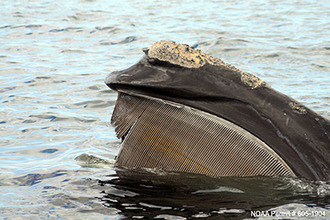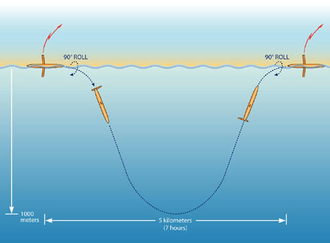Whales are big, tough mammals. But they get stranded on unfamiliar shores, they get hit by ships’ propellers – and even get caught in underwater installations. Anything that can help them is valuable – and a new underwater robot does exactly that. By Jeremy Torr.
Woods Hole, Maine, 2 August 2013. Two underwater “glider” autonomous robot vehicles equipped with instruments designed to "listen" for the calls of whales detected nine endangered North Atlantic right whales in the Gulf of Maine earlier this year. As a result local fisheries authorities established a "dynamic management area," where ship captains were asked to slow vessels to avoid accidentally hitting a surfaced whale.

Right whales are an endangered species, so anything that helps them avoid danger is a benefit to maintaining numbers
The robot project, led by Woods Hole Oceanographic Institution (WHOI) scientists Mark Baumgartner and Dave Fratantoni, uses the ocean-going robots and their digital acoustic monitoring (DMON) instruments to detect and classify calls from four species of whales – sei, fin, humpback, and right whales. The project ran in an area called the Outer Fall, about sixty miles south of Bar Harbor, Maine. Right whales use this area every year between November and January as a mating ground.
The battery powered gliders – two-metre-long, torpedo-shaped autonomous vehicles with short wings – move up, down, and through the water by changing their buoyancy and using wings to provide lift. Extremely quiet, the gliders are equipped with an underwater microphone on the underside, and a satellite antenna on the tail section. The vehicle surfaces every few hours to get a GPS position and transmit recorded data to land-based computers.
Using their onboard equipment, the glider robots reported the whales to shore-based researchers within hours of hearing them, demonstrating a new and powerful tool for anticipating harm to endangered species.
Smart Swimmers
"We put two gliders out in the central Gulf of Maine to find whales for us," says Baumgartner. "They reported hearing whales within hours of hitting the water. They did their job perfectly."

The underwater gliders are incredibly efficient - but most importantly, very uninvasive
Using the gliders's reconnaissance data and continued real-time updates, the science team was able to locate whales in just a few hours of searching. "We found our first right whale on the first day that we were surveying in decent weather conditions because the gliders were up there doing the leg work for us, to tell us where the animals were in real time," says Baumgartner. Often, high winds and rough seas make studying the animals very difficult during their traditional time in the area.
"We've been doing visual based surveys for a long time – either from a plane or a boat. They have a lot of value, but they are limited, especially at certain times of the year," says Sofie Van Parijs, leader of the Passive Acoustic Research Group at NOAA's Northeast Fisheries Science Center (NEFSC).
"These gliders provide a great complement to this system. Knowing where right whales are helps you manage interactions between an endangered species and the human activities that impact those species." The robots surveyed the area for three weeks, sending data to the researchers every two hours via satellite before being recovered by the research vessel Endeavor.
The success of the project is a result of years of collaboration among engineers, biologists and physical oceanographers at WHOI, scientists at the NEFSC Protected Species Branch in Woods Hole, and federal funders like the Office of Naval Research and NOAA's Applied Science and Technology Working Group Program.

The gliders take a sine-wave path through the ocean, autonomously listening for whales up to three weeks at a time
"No one of us could've done this project alone. But by teaming up, we created a really nice group of people with expertise that was tailor made for this problem," says Baumgartner. "Now, we can know that there's an animal in a particular part of the ocean within hours of a call being made, as opposed to months later, when remote instruments have been retrieved and the data reviewed.”
In addition to helping protect whales, the project used the robot gliders to collect biological samples of tiny crustaceans or zooplankton which the whales feed on, to understand how they impact the whale's feeding and behaviour.
"We wanted to figure out what right whales were feeding on in this area," says Baumgartner. "We took profiles of the temperature and the salinity of the water and sampled zooplankton throughout the water column to understand what might make this area attractive to right whales." Analysis of the data is in progress now.
For more info on Woods Hole go to: http://www.whoi.edu/